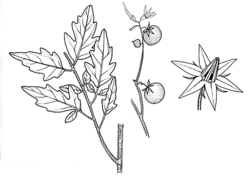Common name: Tomato
Solanum lycopersicum L. APNI* Synonyms: Lycopersicon lycopersicum (L.) H.Karst. ex Farw. APNI*
Lycopersicon esculentum Mill. APNI*
Lycopersicon lycopersicum (L.) H.Karst. ex Farw. APNI*
Lycopersicon lycopersicum (L.) H.Karst. ex Farw. APNI*

Description: Short-lived perennial herb, 0.5–1.5 m high, often densely hairy.
Leaves deeply pinnate to pinnatisect with 7–9 major lobes, ovate in outline, to 30cm long and 10cm wide; petiole 2–5cm long.
Calyx lobes narrow-ovate, 4–10 mm long. Corolla to 25mm diam., yellow; lobes 5, narrow-triangular, to 10 mm long, often reflexed. Anthers 5–10 mm long, including sterile appendage 2–3 mm long.
Berry globose or depressed-globose, 10–20 mm diam., 2-locular, red at maturity.
Flowering: late spring and summer.
Distribution and occurrence: Escape from cultivation, not widely naturalised. Native to South America.
NSW subdivisions: *CC, *ST, *LHI
Other Australian states: *Qld
The cultivated forms usually have larger, multi-locular fruit and corolla 6–9-lobed. Previously known under the genus Lycopersicon, but numerous molecular phylogenetic studies of the Solanaceae has confirmed that Lycopersicon is a deeply nested clade within Solanum.
Text by A. Orme 2019
Taxon concept:
APNI* Provides a link to the Australian Plant Name Index (hosted by the Australian National Botanic Gardens) for comprehensive bibliographic data
***The AVH map option provides a detailed interactive Australia wide distribution map drawn from collections held by all major Australian herbaria participating in the Australian Virtual Herbarium project.
|


